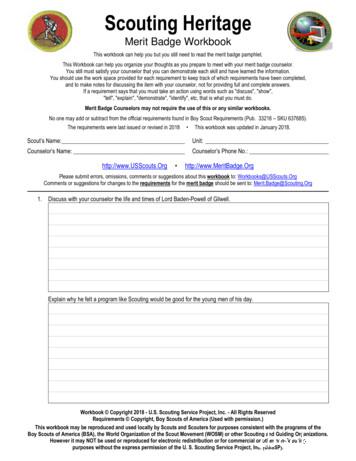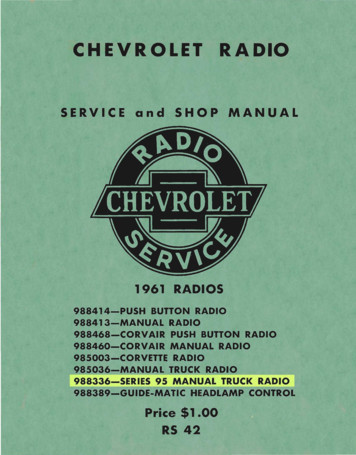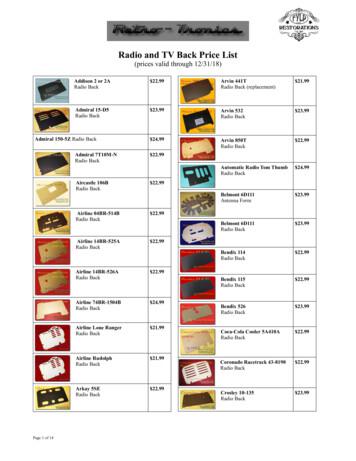RADIO - Filestore.scouting
R ADIOSTEM-Based
BOY SCOUTS OF AMERICAMERIT BADGE SERIESR adio“Enhancing our youths’ competitive edge through merit badges”
Radio1. Explain what radio is. Then discuss the following:(a) The differences between broadcast radio and hobby radio(b) The differences between broadcasting and two-way communications(c) Radio station call signs and how they are used in broadcast radioand amateur radio(d) The phonetic alphabet and how it is used to communicate clearly2. Do the following:(a) Sketch a diagram showing how radio waves travel locally and aroundthe world.(b) Explain how the radio stations WWV and WWVH can be used to helpdetermine what you can expect to hear when you listen to a shortwave radio.(c) Explain the difference between a distant (DX) and a local station.(d) Discuss what the Federal Communications Commission (FCC) does and howit is different from the International Telecommunication Union.3. Do the following:(a) Draw a chart of the electromagnetic spectrum covering 300 kilohertz (kHz)to 3,000 megahertz (MHz).(b) Label the MF, HF, VHF, UHF, and microwave portions of the spectrum onyour diagram.(c) Locate on your chart at least eight radio services, such as AM and FMcommercial broadcast, citizens band (CB), television, amateur radio (at leastfour amateur radio bands), and public service (police and fire).4. Explain how radio waves carry information. Include in your explanation: transceiver, transmitter, receiver, amplifier, and antenna.5. Do the following:(a) Explain the differences between a block diagram and a schematic diagram.(b) Draw a block diagram for a radio station that includes a transceiver,amplifier, microphone, antenna, and feed line.(c) Discuss how information is sent when using amplitude modulation (AM),frequency modulation (FM), continuous wave (CW) Morse Code transmission,single sideband (SSB) transmission, and digital transmission.
(d) Explain how NOAA Weather Radio (NWR) can alert you to danger.(e) Explain how cellular telephones work. Identify their benefits and limitations in an emergency.6. Explain the safety precautions for working with radio gear, including the conceptof grounding for direct current circuits, power outlets, and antenna systems.7. Visit a radio installation (an amateur radio station, broadcast station, or publicservice communications center, for example) approved in advance by your counselor. Discuss what types of equipment you saw in use, how it was used, whattypes of licenses are required to operate and maintain the equipment, and thepurpose of the station.8. Find out about three career opportunities in radio. Pick one and find out theeducation, training, and experience required for this profession. Discuss thiswith your counselor, and explain why this profession might interest you.9. Do ONE of the following (a OR b OR c OR d):(a) Amateur Radio (1) Tell why the FCC has an amateur radio service. Describe activitiesthat amateur radio operators can do on the air, once they have earned anamateur radio license. (2) Explain differences between the Technician, General, and Extra Classlicense requirements and privileges. Explain who administers amateurradio exams. (3) Explain at least five Q signals or amateur radio terms. (4) Explain how you would make an emergency call on voice or Morse code. (5) Explain the differences between handheld transceivers and home “base”transceivers. Explain the uses of mobile amateur radio transceivers and amateur radio repeaters. (6) Using proper call signs, Q signals, and abbreviations, carry on a10-minute real or simulated amateur radio contact using voice, Morse code,or digital mode. (Licensed amateur radio operators may substitute five QSLcards as evidence of contacts with five amateur radio operators.) Properlylog the real or simulated ham radio contact, and record the signal report.(b) Radio Broadcasting (1) Discuss with your counselor FCC broadcast regulations. Include powerlevels, frequencies, and the regulations for low-power stations. (2) Prepare a program schedule for radio station “KBSA” of exactly onehalf hour, including music, news, commercials, and proper station identification. Record your program on audiotape or in a digital audio format,using proper techniques. (3) Listen to and properly log 15 broadcast stations. Determine theprogram format and target audience for five of these stations. (4) Explain to your counselor at least eight terms used in commercialbroadcasting, such as segue, cut, fade, continuity, remote, Emergency AlertSystem, network, cue, dead air, PSA, and playlist.
(5) Discuss with your counselor alternative radio platforms such as internetstreaming, satellite radio, and podcasts.(c) Shortwave and Medium-Wave Listening (1) Listen across several shortwave bands for four one-hour periods—at leastone period during daylight hours and at least one period at night. Log the stations properly and locate them geographically on a map, globe, or web-basedmapping service. (2) Listen to several medium-wave stations for two one-hour periods,one period during daylight hours and one period at night. Log thestations properly and locate them on a map, globe, or web-basedmapping service. (3) Compare your daytime and nighttime shortwave logs; note thefrequencies on which your selected stations were loudest during each session. Explain differences in the signal strength from one period to the next.(4) Compare your medium-wave broadcast station logs and explain why some distant stations are heard at your location only during the night.(5) Demonstrate listening to a radio broadcast using a smartphone/cell phone. Include international broadcasts in your demonstration.(d) Amateur Radio Direction Finding (1) Describe amateur radio direction finding and explain why direction findingis important as both an activity and in competition. (2) Describe what frequencies and equipment are used for ARDF orfox hunting. (3) Build a simple directional antenna for either of the two frequencies usedin ARDF. Participate in a simple fox hunt using your antenna along with a(4)provided receiver.(5) Show, on a map, how you located the “fox” using your receiver.
.Radio ResourcesRadio ResourcesScouting LiteratureComputers, Electricity, Electronics,Emergency Preparedness, Energy,Robotics, and Search and Rescuemerit badge pamphletsVisit the Boy Scouts ofAmerica’s official retail website(with your parent’s permission)at http://www.scoutstuff.orgfor a complete listing of allmerit badge pamphlets andother helpful Scouting materialsand supplies.Books and Other ResourcesMany of the books, CDs, and otherresources listed here are available fromthe American Radio Relay League.See page 96 for contact information.Amateur RadioAlvareztorres, Al, AA1DO, and Ed Hare,W1RFI, compilers. Ham Radio FAQ.American Radio Relay LeagueInc., 2001. Answers to frequentlyasked questions about antennas,station setup and operation, andother issues.Amateur Radio Today. ARRL Inc., 2003.Six-minute video narrated by formerCBS news anchor Walter Cronkite,KB2GSD; showcases the public service contributions made by hams.The ARRL Emergency CommunicationHandbook. ARRL Inc., 2005. Forhams who want to help withcommunications during emergenciesor disasters.The ARRL Ham Radio License Manual.ARRL Inc., 2010. A beginners’ guideto amateur radio and preparation forthe ham radio license test.Barasch, Lynne. Radio Rescue. Farrar,Straus and Giroux, 2000. The story ofa young amateur radio operatorwhose skills led to the rescue of afamily stranded by a hurricane.Basic Technology for the AmateurRadio Enthusiast. Alpha DeltaCommunications Inc., 2000.Basic electronics, a brief historyof radio, and a virtual tour througha receiver. Includes book with23-minute VHS videotape.Radio 93
Radio Resources.Getting Started With Ham Radio. ARRLInc., 2006. A guide to your firstamateur radio station: choosing andinstalling equipment, making yourfirst voice contacts, setting up fordigital operating, operating onvarious bands and modes, etc.Hallas, Joel, W1ZR. Basic Radio:Understanding the Key BuildingBlocks. ARRL Inc., 2005. An introduction to radio with simple, build-ityourself projects.Silver, H. Ward. Ham Radio forDummies, 2nd ed. John Wiley &Sons, 2013.Understanding Basic Electronics.ARRL Inc., 2010. Simple guide forelectronics beginners with explanations of basic electronics principlesand how components work.Your Introduction to Morse Code. ARRLInc., 2006. Morse code instructionand practice for those who want tolearn the “universal language” ofham radio. Includes two audio CDsand instruction booklet.Broadcast Radio andShortwave ListeningBureau of Labor Statistics, U.S.Department of Labor. OccupationOutlook Handbook, 2012–13 ed.See “Media and Communication,”online at oField, Shelly. Career Opportunities inRadio. Checkmark Books, 2004.Profiles of more than 70 careeropportunities in the radio business.World Radio TV Handbook: TheDirectory of Global Broadcasting.WRTH Publications. Publishedannually, a guide to the world ofradio including domestic radioservices and broadcasters transmitting internationally.AcknowledgmentsThe Boy Scouts of America is grateful tothe following for their work on this revision of the Radio merit badge pamphlet:In particular, Mike Brown, WB2JWD,Harford, New York, who coordinatedthe overall revision; Bill Burns,WA6QYR, Ridgecrest, California; AllanKoch, KA8JJN, Clinton Township,Michigan; and Larry Wolfgang WR1B,Newington, Connecticut, for contributingto the “Amateur Radio” section andrelated portions of the pamphlet.Thanks to Donald L. Perkins, N2IVW,operations manager and engineer,Central New York Radio Group, for hishelp in revising the “Broadcast Radio”section of the pamphlet.The BSA thanks the staff and volunteers of the American Radio RelayLeague for many contributions over theyears, and for those materials reprintedwith the permission of the ARRL fromits publications and website.
merit badge pamphlets Books and other Resources Many of the books, CDs, and other resources listed here are available from the American Radio Relay League. See page 96 for contact information. aMaTEUR Radio Alvareztorres, Al, AA1DO, and Ed Hare, W1RFI, compilers. Ham Radio FAQ. Amer
Achieve Real Growth through Scouting Look at the picture of the bridge and Baden Powell from President Monson’s office. How is Scouting a bridge? Share your thoughts. Determine how you can bring about real growth for individuals and the Church through Scouting (see “A Century of Scouting in the Church,” Ensign, Oct. 2013, 11–15). 1
Scouting Heritage - Merit Badge Workbook Page. 2 of 7 Include in your discussion how Scouting was introduced in the United States, and the origins of Boy Scouting and Cub Scouting under Baden-Powell. Introduction in the United States: Origins of B
62 american cultures resources. Resources scouting literature American Heritage, American Labor, Archaeology, Architecture, Citizenship in the Community, Citizenship in the Nation, Citizenship in the World, Communication, Family Life, Genealogy, Indian Lore, Law, Music and Bugling, Reading, Scouting Heritage, and Stamp Collecting merit
SERVICE and SHOP MANUAL 1961 RADIOS 988414-PUSH BUTTON RADIO 988413-MANUAL RADIO 988468-CORVAIR PUSH BUTTON RADIO 988460-CORVAIR MANUAL RADIO 985003-CORVETTE RADIO 985036-MANUAL TRUCK RADIO 988336-SERIES 95 MANUAL TRUCK RADIO 988389-GUIDE-MATIC HEADLAMP CONTROL Price 1.00 . 89 switch and must be opened by speaker plug when testing radio.
Wavestown Answer Key Radio Waves Ray’s TV - TV reception uses radio waves Satellite Dish on top Ray’s - receives movies via radio waves from a satellite Taxi - Car radio reception uses radio signals Taxi - Driver receives instructions on a CB radio which uses radio waves Radio Tower - broadcast’s radio signals
Radio and TV Back Price List (prices valid through 12/31/18) Addison 2 or 2A Radio Back 22.99 Admiral 15-D5 Radio Back 23.99 Admiral 150-5Z Radio Back 24.99 Admiral 7T10M-N Radio Back 22.99 Aircastle 106B Radio Back 22.99 Airline 04BR-514B Radio Back 22.99 Airline 14BR-525A Radio Ba
Mutual Agreement and Review 11. Useful references . Welcoming adults to Scouting - Induction . the World Scout Committee, and the World Scout Bureau. Mission "The Mission of Scouting is to contribute to the education of young people, through a value system . The scout method is the way we do Scouting; it is an educational framework unique .
quality results of AGMA Class 10 with a double cut cycle and AGMA Class 9 with a single cut cycle can be expect-ed. The 100H weighs 7,100 lbs with a cube size of 78” X 64” X 72” high. For more information, contact Bourn & Koch at (815) 965-4013, Boeing F/A-18E/F Super Hornet Completes First AESA Flight In a press release dated August 13, 2003, it was announced that the Boeing F/A-18E/F .























